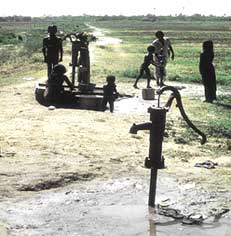Faucets of the problem
Faucets of the problem

Empty wells and year-long thirst
a tropical country, India has labyrinthine river networks and numerous water sources fed by the yearly rains. The country receives 400 mham of rain and snowfall. Another 20 mham flow in as surface water from neighbouring countries. These 420 mham provide India with river flows of 180 mham. Over 75 per cent of this constitute the annual Indian rains. And another 67 mham is available as groundwater. Still, for reasons unknown, India is short of drinking water. How did the country come to this?
The decentralised rainwater-harvesting systems that had ensured water supply for irrigation and had earned India the prestigious epithet “The land of gold”, are now as jaded as the epithet. Rulers who ruled the country through the ages, had deep faith in these systems, encouraging the masses to build these for themselves and their communities. As incentives, rulers would not levy taxes for a period of time on lands owned by someone who has built a tank. Dasabandhani inam or the dasavanda and the katu kodage were such incentives ancient rulers, like the Vijayanagara Kings of India’s south, granted to farmers who built water-harvesting structures.
It is not that the state and Union governments are disinterested now: in 1997-98 alone, they collectively spent some Rs 2,200 crore to create safe water sources, states N C Saxena. But India’s huge population still leaves a great many Indians thirsty. Theories and postulates have explained why water continues to be a luxury in India. In many areas, mineral and chemical contamination of groundwater is the cause. The experts identified the problems long back with their theories. However, nothing has been done to solve them. A bigger issue for planners is the spread of water-borne diseases. Case studies from nine areas living with drinking water-related problems show that unless there are comprehensive programmes for reviving India’s water resources, the vicious cycle of water scarcity and water-borne diseases will continue.
CHERRAPUNJI (MEGHALAYA)
Source:Rain and municipal services
Problem: Deforestation, run off
All rain, no water
A mong the chief causes for the water crisis in Meghalaya is deforestation which, in hilly regions, has led to formidable run-off of rainwater. Earlier, with forests dotting India’s hill states, this could be easily avoided. Though evident in many regions, Cherrapunji in the tiny Indian northeast hill state of Meghalaya, emerges as one such glaring instance of water scarcity following extensive local deforestation.
Once upon a time Cherrapunji enjoyed the distinction of enjoying the greatest amount of rainfall in the world. When it rains here, it pours. The region is used to an average annual rainfall of some 11,000 mm. So the fact that Cherrapunji is plagued by an acute water shortage half the year comes across as one of nature’s uglier ironies.
Student Gabriel Wangchung des







